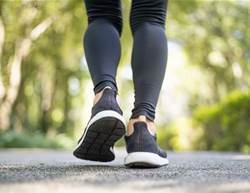“I would literally come home from work, sit down and be fast asleep by 6 PM,” she recalls. She spent weekends in pajamas with her toddler son, napping and going to bed at the same time he did—all while suffering intense stomach pain, which was later diagnosed as irritable bowel syndrome. But as time went by, tiredness would become the least of her troubles. “Over the years, pain overtook fatigue as my defining issue,” she says.
She saw multiple doctors who ran endless blood tests and took X-rays but found no evidence of any illness. Her undefined condition started to take a toll on her marriage, and she and her first husband eventually divorced. “It was understandable, really,” she says of the relationship breaking down. “How could I keep on saying there was a problem when all the medical evidence proved otherwise?”

It wasn’t until the year 2000, at age 36, that Marinelli finally got some answers. A new doctor noticed she flinched when he touched her tender points—and diagnosed her with fibromyalgia. Upon finally being able to name her condition, she cried “tears of joy and relief," she recalls. "I wasn’t mad; I was vindicated. It wasn’t all in my head.”
Still, the prognosis sounded grim. Told she would likely end up in a wheelchair, she was prescribed antidepressants and painkillers. “The doctor told me those were my only options for treatment,” she says. "But being on strong medication for the rest of my life just didn’t sit well with me." She decided to flush the pills down the toilet.
Seeking new options
Determined to explore other avenues, Marinelli sought out alternative ways to manage her muscle stiffness and neck and back aches. And she forced herself to keep working through the pain.
“From very early on,” she says, “I believed that by getting up each morning and getting ready for work, I was sending a message to my body that I was fighting back and not prepared to give in to this condition. I knew I had to keep myself mobile.” She struggled for years to do so, trying various exercise regimes that left her debilitated. Swimming drained her. Treadmill and stationary bike sessions at the gym caused her symptoms to flare. And then she learned about the significant connection between stress and her symptoms.
Marinelli began reading about the Dalai Lama, and ultimately enrolled in a meditation course at a Tibetan monastery in Scotland, where she meditated at the feet of Buddhist monks. Yoga was a natural next step. While it’s been established that the ancient practice can help manage pain, Marinelli struggled with some initial self-doubt.
Having attended a few yoga workshops at her local gym in the past, she had always felt like a “useless” outsider who “couldn’t keep up” because she wasn’t a “bendy Wendy.” But in the fall of 2013, after she’d begun to feel the positive effects of meditation, she took baby steps to get back into it, doing gentle stretches at home with the help of YouTube videos. She quickly noticed an uptick in her energy levels and was immediately hooked.

“For both yoga and meditation, the impact was pretty much instant,” she says, noting that she felt less stiffness after a single yoga session. “It was such a gentle yoga practice that I was doing, but the sense of achievement was amazing. As each week passed, I could tell my body was freeing itself and I could hold my positions for longer without as much discomfort.”
Marinelli now wakes up every day at 5:30 AM to meditate and stretch for at least 10 minutes before work. She favours sun salutations in the mornings and does additional stretches that focus on her neck and shoulders while sitting at her desk throughout the day. She also likes child’s pose for stretching out her back, though even after years of practice, she still finds the position “intense.”
Each part of her routine has its purpose: “The meditation allows me to sit and at times experience the discomfort [from my fibromyalgia symptoms]. But with perseverance and practice, I am able to breathe through the pain,” she says. She’s careful to clarify that her healthy lifestyle isn’t a cure, but a management method. She still suffers the occasional flare. “I don’t think that my fibromyalgia symptoms have been eliminated, but these activities have helped me manage the condition to a point where I can pretty much lead a normal life.”

Three years ago, as Marinelli—now a wellness coach, blogger, and skincare company rep—approached her 50th birthday, “I could officially say that I had battled fibromyalgia for over half my life. I decided that the second half of my life was going to be better, health-wise. I was already working on the outside with my yoga but decided that more answers would lie with what I was putting in my body.”
Determined to overhaul her diet, she did a 12-day raw food cleanse, gave up processed food and caffeine, and became a pescetarian. In an effort to cut out dairy, which irritates her stomach, she replaced her beloved chai lattes with a daily cup of hot water, lemon and apple cider vinegar. She started drinking more water. Later, she added a daily cup of bone broth to her routine; the collagen it contains is said to help reduce joint pain.
It took Marinelli a year to transform her diet, but over the course of that time, “I saw huge changes in my fibromyalgia symptoms,” she says. “I felt amazing. And I had so much energy.” So much, in fact, that now, in addition to her morning stretches, she takes a weekly, hour-long yoga class geared toward people with chronic conditions. The focus of the class is on asana (seated poses), breathwork, meditations and mantras.
However, notes Marinelli, “I don’t believe that any one position is the answer” to combating her pain. “It’s more that I am actually moving my body and not giving in to fibromyalgia. The fact that I am trying to remain positive, active and look after my body has had the biggest effect on my symptoms. Just being on my yoga mat is empowering.”










